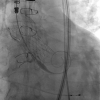Successful Transcatheter Aortic Valve Implantation in a Patient with Radiation-induced Aortic Stenosis for Mediastinal Hodgkin Lymphoma
- PMID: 33116008
- PMCID: PMC8079924
- DOI: 10.2169/internalmedicine.5310-20
Successful Transcatheter Aortic Valve Implantation in a Patient with Radiation-induced Aortic Stenosis for Mediastinal Hodgkin Lymphoma
Abstract
Aortic stenosis (AS), a late complication of thoracic radiation therapy for chest lesions, is often coincident with porcelain aorta or hostile thorax. We herein report a 59-year-old man with a history of mediastinal Hodgkin lymphoma treated with radiation therapy but later presenting with heart failure caused by severe AS. Severe calcification in the mediastinum and around the ascending aorta made it difficult to perform surgical aortic valve replacement. The patient therefore underwent transcatheter aortic valve implantation (TAVI). It is important to recognize radiation-induced AS early, now that TAVI is a well-established treatment required by increasing numbers of successfully treated cancer patients.
Keywords: Hodgkin lymphoma; TAVI; aortic stenosis; calcification; radiation.
Conflict of interest statement
Figures



References
Publication types
MeSH terms
LinkOut - more resources
Full Text Sources
Other Literature Sources
Medical
Research Materials

